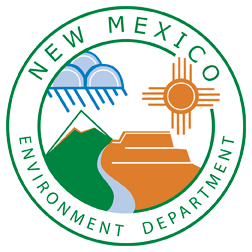Understanding the Lead Service Line Inventory Requirements
Community and Non-Transient, Non-Community (NTNC) Public Water Systems must complete and submit to NMED DWB a lead service line inventory by October 16, 2024. The Lead and Copper Rule Revisions require Community and Non-Transient, Non-Community public water systems to identify the service line materials of all service connections in their distribution system regardless of ownership status.
The LCRR establishes the minimum information federally required in your service line inventory, publicize they service line inventory results, and when update to the inventory are required. However, it is highly recommended to fill out as much information as you can in your service line inventory as part of a robust asset management plan.
Additional information can be found by reviewing the Code of Federal Regulations (title-40/part-141/subpart-I) and the lead service line inventory requirements at Code of Federal Regulations (title-40/section-141.84. EPA has also published guidance for developing inventories that can be found at Lead and Copper Rule Revisions.
The Association of Safe Drinking Water Administrators (ASDWA) has a free webinar series on LCRR and service line inventories, with monthly presentations as well as past recordings.
Additionally, EPA published a webinar on August 10, 2022, that addresses guidance for developing service line inventories and finding information.
Step 1: Gather data
Community and Non-Transient, Non-Community (NTNC) Public Water Systems need to find out the materials of the service line for both the public and private portions of the service line, even if the line is completely privately owed. First, look at the information you do have and identify what is still unknown. Then prioritize how you will reduce the number of unknowns. Some of the strategies for identifying and inventorying your system’s service line materials are noted below.
Historical records
- Utility records, local plumbing codes that identify year of lead ban adopted before 1986 federal ban.
- Ordinances related to discontinuing lead in service line installations.
- Distribution system maps and drawings (as-builts).
- Building year and construction records with respect to the 1986 lead ban.
- Tap/tie cards with connection year.
- Plans from water main installation, rehabilitation, and/or replacement.
- Plumbing permits and permit amendments.
Customer-driven data
- Information provided by customers, such as personal historical records.
- Construction year and records, and plans and drawings.
- Previous service/repair reports.
- Information from homeowner insurance.
- Inspection reports, photo documentation of materials used inside the building.
- LSL replacement documentation (e.g., plumber invoice or plans and drawings from rebuilding).
- Information obtained at the request of the water system, such as a survey or scratch and magnet tests or photos.
Templates for customer driven data can be found on the LCRR Templates and Documents Page
Sampling
- Scratch and magnet tests.
- Scratch test: use of a key, coin, or other sharp metal object to scratch the outer surface of the pipe—lead is easy to scratch and leaves a silver and shiny surface underneath.
- Magnet test: magnets stick to galvanized or iron pipes but not to lead or copper pipes.
[youtube_embed url=’https://www.youtube.com/embed/qu6gBPkvdNE?si=75d0kv8aXcEhVemD’]
- Camera scoping.
- Inspection of the pipe interior using a fiber-optic camera inserted inside the service line.
- Predictive modeling and machine learning (pending guidance from EPA).
- Geospatial approach to predict the likelihood that a residence has an LSL on the basis of neighboring field data (i.e., house inspection) and secondary information (i.e., construction year and city records).
- Potholing, vacuum excavation, and hydro-excavation.
- Potholing: digging a hole to expose a segment of the service line using a backhoe or hand tools.
- Vacuum excavation: using high-velocity, high-pressure air to break up the soil to create a hole to expose a segment of the service line.
- Hydro-excavation: using high-velocity, high-pressure water to break up the soil to create a hole to expose a segment of the service line.
- Visual inspection.
[youtube_embed url=’https://www.youtube.com/embed/iwIh2ICTHOc?si=TX8xXyy8t_nW68UV’]
- Curb box inspection.
- Point of entry, in home/premise plumbing (by water system).
- Meter pit inspection.
Additional Resources include the EPA’s Guidance for Developing and Maintaining Service Line Inventories The guidance is available to view on the EPA Revised Lead and Copper Rule.
Step 2: Document your data in an electronic database
Public water systems should have the ability to make data accessible to the public and to the New Mexico Environment Department in an electronic format such as a database or spreadsheet. The minimum fields required are:
- Location identifier such as address or GIS coordinates.
- Material type of privately owned side (lead, non-lead, galvanized in need of replacement, unknown).
- Material type of publicly owned side (lead, non-lead, galvanized in need of replacement, unknown).
- Source of information used to determine material type (type of record, inspection, etc.).
Learn more about service line material types: Lead Service Line Material Types and Definitions.
Step 3: Keep your Lead Service Line Inventory up-to-date
Many systems will have unknown service line materials in their initial inventory. That’s okay, once you’ve identified these lines as unknown materials, you can create a plan for coming back and determining the missing information.
- At minimum your inventory needs to be updated at the same frequency as your lead and copper sample schedule, at most on an annual basis. For systems on a three-year monitoring, you may want to update the inventory annually or in real-time with projects and renovations to keep customers informed.
- How to prioritize determining unknown services lines: based on factors including but not limited to the targeting of areas with known lead service lines, service lines which serve disadvantaged consumers and/or populations most sensitive to the effects of lead.
Lead Service Line Inventory Customer Notifications and Communication
Keeping customers informed about the importance of conducting lead service line inventories and reducing lead exposure may encourage customers to participate in the inventory and replacement process.
After the initial Inventory
In addition to the public accessibility requirements, the LCRR also requires all systems to inform all persons served by the service connection with a lead service line (LSL), galvanized requiring replacement (GRR), following completion of the initial inventory.
A water system must provide the initial notification within 30 days of completion of the lead service line inventory required under the LCRR and repeat the notification on an annual basis until the entire service connection is no longer a lead, galvanized requiring replacement, or lead status unknown service line. For new customers, water systems shall also provide the notice at the time of service initiation.
Water systems must make the inventory publicly accessible, including a location identifier for each LSL and GRR. The LCRR requires water systems that serve more than 50,000 people to provide their inventory online (40 CFR §141.84(a)(8)).
Water systems serving 50,000 or fewer people are not required to post their inventories online, as long as they are publicly accessible in some fashion. This may include availability by mail or in-person at the water system’s office. EPA encourages all water systems to consider providing online inventory access.
Types of communications for lead service line inventories
- Consumer Confidence Report: in addition to the information about reducing lead exposure from drinking water, systems will need to include information on how to access information about the lead service line inventory.
- New services: Water systems must provide notice to customers at the time that service to the water system, if they are served by a lead service line, galvanized in need or replacement, or lead status unknown service line.
- Annual notification: Customers served by a lead service line or galvanized line in need of replacement will need to be notified annually about the health risks, and steps they can take to reduce exposure.
Return to Lead and Copper Rule Revision

